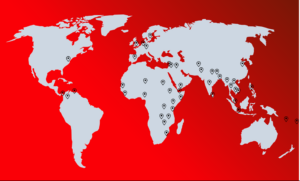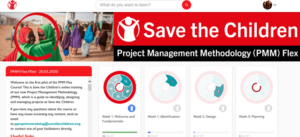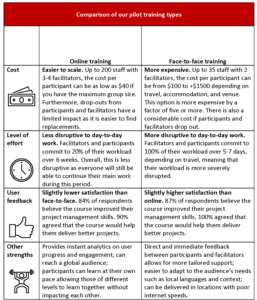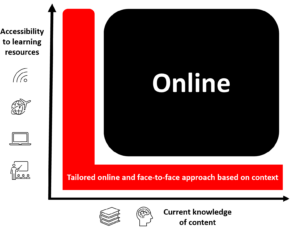
Save the Children is a global organisation running projects around the world from Singapore to Sri Lanka, Sudan, and Sweden. Each country has its own requirements in delivering training such as travel restrictions, working languages, and internet access to name but a few. Due to technological limitations, we have tended to favour more expensive and time-consuming face-to-face training. This has largely ensured quality training for most of our audience, but logistical and resource limitations meant that not all staff got the training they needed – when they needed it.
In early 2020, Save the Children ran an ambitious training pilot with nearly 300 staff across 40 countries. We compared the delivery of two versions of the same 30-40 hour project management training, one online and the other face-to-face, to better understand how to upskill our worldwide network of 24,000 staff across 117 countries over the coming years.

Image 1: The pilot locations were spread out across forty countries in five continents ensuring we had a good sample population to test our approaches.
How did we deliver the online and face-to-face training?
During our pilot, it was important to have a mixture of audiences to compare how well each training type worked in different contexts. Our face-to-face training was an interactive five-day workshop with numerous games, group exercises and discussions. We tested it with senior project managers from over ten Asia Country Offices in Nepal, followed by Sudanese staff in Khartoum and Darfur.
For our online training*, we did a six-week self-paced course with social learning at the heart of it and gamification elements via a points-based progression system and leader board. Our global group of participants earned progression points by absorbing videos and readings, discussing with their peers, and uploading weekly exercises. To achieve this, we used the Curatr platform provided via our Humentum membership, which has already delivered award-winning online training to thousands of participants in our peer organisations.
* Please note that for our online training we implemented an instructor-led course with social learning elements where participants had to engage with each other and the facilitators. Therefore, the conclusion in this blog may not be valid for a self-paced online course.

Image 3: A screenshot from the home page of the PMM Flex course showing the different modules that participants will study throughout the course.
Our findings
We completed extensive pre- and post-course surveys. The results were surprising with online comparing favourably to face-to-face training in many of our learner satisfaction indicators, and beating it on accessibility, scalability, and value-for-money. Our pilot found that although there remains a place for face-to-face training in our organisation, it should only be part of a bespoke training package tailored to a specific location’s needs and context.

The conclusion that online can be as good as face-to-face will not surprise many who have long transitioned their learning to online using platforms such as Coursera, Disaster Ready, and Kaya. However, this has been part of a bigger journey that Save the Children has been undertaking to increase its localisation efforts and upskill its field offices by investing in staff training programmes. This shift has been largely made possible over the past few years by:
Dramatic increases in internet penetration worldwide. Internet access is one of the world’s fastest declining problems with 4.5 billion internet users as of 2020, which was a 7% increase from 2019. Yet there are still many ‘unconnected people’, with 27% of them living in Africa, a key operational area for Save the Children.

Image 4: Internet access has increased rapidly, but just over 40% of the world’s total population – roughly 3.2 billion people – remains unconnected to the internet. Source The Next Web Digital Trends 2020.
New technologies being cheaply available such as mobile phones and easy-to-use learning platforms. We designed our new course on a budget of thousands rather than tens or hundreds of thousands. Reduced costs are especially important in the charity sector, where resources are more limited for training.
Good and easy-to-produce training that has a global reach is becoming more achievable at a friendlier price-tag. Unfortunately, this digital acceleration has not happened equally between or even within countries. This was shown by the difficulty experienced by staff accessing content in remote locations such as Yemen and western Africa. There was also the challenge of some staff with limited project management experience needing a more hands-on, direct training, as their pre-existing knowledge of the subject matter area was not as strong as their peers.
As a result, when we looked at our new training strategy, we accepted that the new normal was online, but that a minority of staff needed more bespoke support. This was due to challenges such as accessibility and limited current knowledge in the training subject area (see figure below for an illustration).
Image 5: The Y-axis (Accessibility) is tied to numerous factors such as internet speed, availability of devices, access to physical locations for teaching and/or travel restrictions for trainers. While the X-axis (Current Knowledge) is how well do participants already know and practice the training subject area. Where there is poor accessibility and/or limited knowledge in the training content – a more tailored approach is advised rather than standard online training.
This approach means that we still get the scalability and cost-saving benefits of doing a regular online training for the majority of our staff and are then able to use the time and money saved to deliver more resource-intensive tailored solutions to the minority. This flexible approach ensures that we can reach all our staff with the training that suits their needs.
Some additional reflections from the pilot
The pilot also revealed some interesting observations, which are useful to reflect on regarding future trends in the aid sector and general learning and development.
Creating a more unified organisational culture: By creating an online peer-to-peer learning environment, where learners from all over the world can share their experiences and teach each other, the training contributes to a global organisational culture and the breaking down of siloes between regions. This also supports decentralisation, as staff connect via the courses and do not need to go through the head office to collaborate with colleagues in other parts of the world.
Security and environmental factors: Some of the greatest risks to our staff is when they travel. Although we have had no deaths in recent times due to training, we did recently lose staff in Cambodia during a bus accident and lost another staff member in the 2019 Ethiopian Airlines crash. Avoiding unnecessary travel reduces the risk to our staff. It also reduces Save the Children’s environmental impact and avoids the ironic situation that our staff are contributing to the very climate conditions that are impacting the communities they serve.
Diversity and Inclusion: We found that women (especially those who are more senior) were more likely to take the online training compared to face-to-face. Many staff cannot advance in their careers because they do not have the requisite skills. If some groups such as women, those with disabilities, and caregivers, find it harder to access training, this will result in a less diverse leadership that has shown to reduce an organisation’s performance.
Acknowledgements
Special thanks to John Cropper at Pyramid Learning who advised and helped develop our online and face-to-face courses, and Ross Coxon at Humentum who provided the online training software and great support.
Emanuele (Manny) Militello is a Training Online Manager specialised in Project Management at Save the Children International. He has delivered a range of projects and training throughout his career in locations such as Asia, East Africa, and the Middle East. He has been facilitating training for over nine years, including teaching in academia and leading an award-winning learning programme for inner-city schools. Manny currently lives in London, and out of the classroom and office (when not under lockdown) can be found at a climbing wall, on a yoga mat or ruining songs in karaoke.

